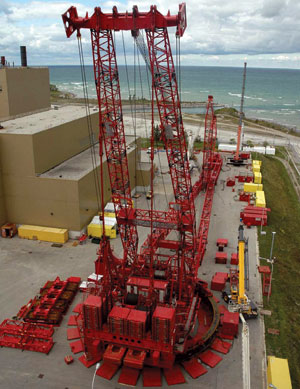...designing, manufacturing and delivering the 32 steam generators; and Siemens Canada Ltd., which is inspecting and refurbishing the two units’ turbine generators and auxiliary systems.

designing, manufacturing and delivering the 32 steam generators; and Siemens Canada Ltd., which is inspecting and refurbishing the two units’ turbine generators and auxiliary systems.
The players were strong, but a lack of coordination made functioning as a team difficult. “With every contractor controlling their own schedules, the project lacked a scheduling standard that contained requirements for logic ties, the precedence diagramming method, open ends, baseline maintenance, etc. There were too many disparate methods being used,” says John Sauger, Bruce Power senior vice president.
Bruce Power hired Sauger in March 2008 from Shaw Federal Operations, Alexandria, Va., where he had been senior vice president. Schedule adherence was 14% per week, he says. In May and June that year, he overhauled the management of the project, and Bruce Power took over control. “We’ve made substantive progress,” he says. Schedule adherence now is 70%. More than 100,000 activities in the network were rescheduled.
“AMEC had a number of highly skilled and knowledgeable managers that came from other industries that AMEC has a core competency in,” such as pulp and paper, but lacked “nuclear-specific knowledge,” Sauger says. So he has paired construction professionals with nuclear experience with AMEC’s managers. Together, “they have generated excellent results,” he says.
Rusty Chain
But “a very small number didn’t have nuclear experience,” counters Peter Bailey, AMEC senior vice president. He notes that this was the Canadian nuclear industry’s first big capital project in years, and “the supply chain was kind of rusty.” In addition, “the project was not well defined at the time of sanction. There was a lot of scope creep,” says Bailey. “Understanding the scope was difficult.”
By the end of 2010, units 1 and 2 will be back in service. Refurbishment of units 3 and 4 is under review. “Today, we are looking at units 3 and 4 entering the construction phase of their refurbishment programs in 2016,” says Sauger. “Our early analysis shows a tremendous time and cost savings if we install new reactors rather than rebuild the existing ones. The lead time for new reactors is four years.”
In the Canadian nuclear industry’s rusty supply chain, Sauger detects opportunity. He is negotiating with a half-dozen nuclear-experienced contractors to form an entity that combines U.S. management expertise with Canadian construction skills to tackle the country’s nuclear market.
Still To Come
Province-owned transmission utility Hydro One plans to construct 180 km of double-circuit 500-kV transmission line from the Bruce Nuclear Generating Station to Milton, Ontario, near Toronto. The $573.6-million line, to be in service by 2011, will deliver power from the refurbished nuclear units as well as the wind farms being built in the area.
Power demand outside Ontario is still growing, and Bruce Power is planning to serve it. In March 2008, Bruce Power Alberta applied to build up to 4,000 MW at a site 30 km north of Peace River, Alberta. In November 2008, Bruce Power officials identified the region between Lloydminster and Prince Albert, Saskatchewan, as “the most viable host” in that province for a 1,000-MW nuclear plant. “Saskatchewan, which is Canada’s fastest-growing province, has a current market of about 3,200 MW and is projecting the need for an additional 1,000-2,200 MW by 2020,” says a Bruce Power spokesman.


Post a comment to this article
Report Abusive Comment